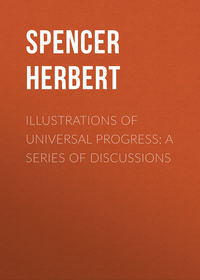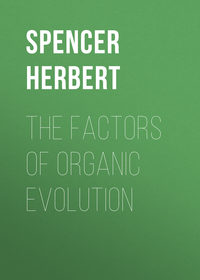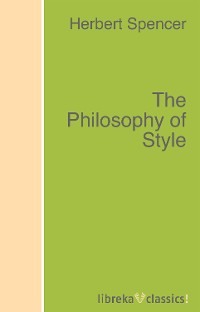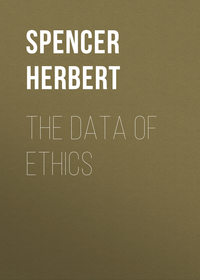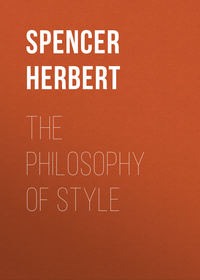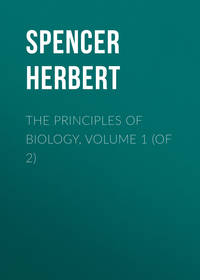 полная версия
полная версияFirst Principles
Concerning Time, relative and absolute, a parallel argument leads to parallel conclusions. These are too obvious to need specifying in detail.
§ 63. Our conception of Matter, reduced to its simplest shape, is that of co-existent positions that offer resistance; as contrasted with our conception of Space, in which the co-existent positions offer no resistance. We think of Body as bounded by surfaces that resist; and as made up throughout of parts that resist. Mentally abstract the co-existent resistances, and the consciousness of Body disappears; leaving behind it the consciousness of Space. And since the group of co-existing resistent positions constituting a portion of matter, is uniformly capable of giving us impressions of resistance in combination with various muscular adjustments, according as we touch its near, its remote, its right, or its left side; it results that as different muscular adjustments habitually indicate different co-existences, we are obliged to conceive every portion of matter as containing more than one resistent position – that is, as occupying Space. Hence the necessity we are under of representing to ourselves the ultimate elements of Matter as being at once extended and resistent: this being the universal form of our sensible experiences of Matter, becomes the form which our conception of it cannot transcend, however minute the fragments which imaginary subdivisions produce. Of these two inseparable elements, the resistance is primary, and the extension secondary. Occupied extension, or Body, being distinguished in consciousness from unoccupied extension, or Space, by its resistance, this attribute must clearly have precedence in the genesis of the idea. Such a conclusion is, indeed, an obvious corollary from that at which we arrived in the foregoing section. If, as was there contended, our consciousness of Space is a product of accumulated experiences, partly our own but chiefly ancestral – if, as was pointed out, the experiences from which our consciousness of Space is abstracted, can be received only through impressions of resistance made upon the organism; the necessary inference is, that experiences of resistance being those from which the conception of Space is generated, the resistance-attribute of Matter must be regarded as primordial and the space-attribute as derivative. Whence it becomes manifest that our experience of force, is that out of which the idea of Matter is built. Matter as opposing our muscular energies, being immediately present to consciousness in terms of force; and its occupancy of Space being known by an abstract of experiences originally given in terms of force; it follows that forces, standing in certain correlations, form the whole content of our idea of Matter.
Such being our cognition of the relative reality, what are we to say of the absolute reality? We can only say that it is some mode of the Unknowable, related to the Matter we know, as cause to effect. The relativity of our cognition of Matter is shown alike by the above analysis, and by the contradictions which are evolved when we deal with the cognition as an absolute one (§ 16). But, as we have lately seen, though known to us only under relation, Matter is as real in the true sense of that word, as it would be could we know it out of relation; and further, the relative reality which we know as Matter, is necessarily represented to the mind as standing in a persistent or real relation to the absolute reality. We may therefore deliver ourselves over without hesitation, to those terms of thought which experience has organized in us. We need not in our physical, chemical, or other researches, refrain from dealing with Matter as made up of extended and resistent atoms; for this conception, necessarily resulting from our experiences of Matter, is not less legitimate, than the conception of aggregate masses as extended and resistent. The atomic hypothesis, as well as the kindred hypothesis of an all-pervading ether consisting of molecules, is simply a necessary development of those universal forms which the actions of the Unknowable have wrought in us. The conclusions logically worked out by the aid of these hypotheses, are sure to be in harmony with all others which these same forms involve, and will have a relative truth that is equally complete.
§ 64. The conception of Motion as presented or represented in the developed consciousness, involves the conceptions of Space, of Time, and of Matter. A something that moves; a series of positions occupied in succession; and a group of co-existent positions united in thought with the successive ones – these are the constituents of the idea. And since, as we have seen, these are severally elaborated from experiences of force as given in certain correlations, it follows that from a further synthesis of such experiences, the idea of Motion is also elaborated. A certain other element in the idea, which is in truth its fundamental element, (namely, the necessity which the moving body is under to go on changing its position), results immediately from the earliest experiences of force. Movements of different parts of the organism in relation to each other, are the first presented in consciousness. These, produced by the action of the muscles, necessitate reactions upon consciousness in the shape of sensations of muscular tension. Consequently, each stretching-out or drawing-in of a limb, is originally known as a series of muscular tensions, varying in intensity as the position of the limb changes. And this rudimentary consciousness of Motion, consisting of serial impressions of force, becomes inseparably united with the consciousness of Space and Time as fast as these are abstracted from further impressions of force. Or rather, out of this primitive conception of Motion, the adult conception of it is developed simultaneously with the development of the conceptions of Space and Time: all three being evolved from the more multiplied and varied impressions of muscular tension and objective resistance. Motion, as we know it, is thus traceable, in common with the other ultimate scientific ideas, to experiences of force.
That this relative reality answers to some absolute reality, it is needful only for form’s sake to assert. What has been said above, respecting the Unknown Cause which produces in us the effects called Matter, Space, and Time, will apply, on simply changing the terms, to Motion.
§ 65. We come down then finally to Force, as the ultimate of ultimates. Though Space, Time, Matter, and Motion, are apparently all necessary data of intelligence, yet a psychological analysis (here indicated only in rude outline) shows us that these are either built up of, or abstracted from, experiences of Force. Matter and Motion, as we know them, are differently conditioned manifestations of Force. Space and Time, as we know them, are disclosed along with these different manifestations of Force as the conditions under which they are presented. Matter and Motion are concretes built up from the contents of various mental relations; while Space and Time are abstracts of the forms of these various relations. Deeper down than these, however, are the primordial experiences of Force, which, as occurring in consciousness in different combinations, supply at once the materials whence the forms of relations are generalized, and the related objects built up. A single impression of force is manifestly receivable by a sentient being devoid of mental forms: grant but sensibility, with no established power of thought, and a force producing some nervous change, will still be presentable at the supposed seat of sensation. Though no single impression of force so received, could itself produce consciousness (which implies relations between different states), yet a multiplication of such impressions, differing in kind and degree, would give the materials for the establishment of relations, that is, of thought. And if such relations differed in their forms as well as in their contents, the impressions of such forms would be organized simultaneously with the impressions they contained. Thus all other modes of consciousness are derivable from experiences of Force; but experiences of Force are not derivable from anything else. Indeed, it needs but to remember that consciousness consists of changes, to see that the ultimate datum of consciousness must be that of which change is the manifestation; and that thus the force by which we ourselves produce changes, and which serves to symbolize the cause of changes in general, is the final disclosure of analysis.
It is a truism to say that the nature of this undecomposable element of our knowledge is inscrutable. If, to use an algebraic illustration, we represent Matter, Motion, and Force, by the symbols x, y, and z; then, we may ascertain the values of x and y in terms of z; but the value of z can never be found: z is the unknown quantity which must for ever remain unknown; for the obvious reason that there is nothing in which its value can be expressed. It is within the possible reach of our intelligence to go on simplifying the equations of all phenomena, until the complex symbols which formulate them are reduced to certain functions of this ultimate symbol; but when we have done this, we have reached that limit which eternally divides science from nescience.
That this undecomposable mode of consciousness into which all other modes may be decomposed, cannot be itself the Power manifested to us through phenomena, has been already proved (§ 18). We saw that to assume an identity of nature between the cause of changes as it absolutely exists, and that cause of change of which we are conscious in our own muscular efforts, betrays us into alternative impossibilities of thought. Force, as we know it, can be regarded only as a certain conditioned effect of the Unconditioned Cause – as the relative reality indicating to us an Absolute Reality by which it is immediately produced. And here, indeed, we see even more clearly than before, how inevitable is that transfigured realism to which sceptical criticism finally brings us round. Getting rid of all complications, and contemplating pure Force, we are irresistibly compelled by the relativity of our thought, to vaguely conceive some unknown force as the correlative of the known force. Conditioned effect and unconditioned cause, are here presented in their primordial relation as two sides of the same change; of which we are obliged to regard the conditioned and the unconditioned sides as equally real: the only difference being that the reality of the one is made relative by the imposition of the forms and limits of our consciousness, while the reality of the other, in the absence of those forms and limits, remains absolute.
Thus much respecting the nature of our ultimate scientific ideas. Before proceeding to our general inquiry concerning the causes of Evolution, we have still to consider certain ultimate scientific truths.
CHAPTER VI.
THE INDESTRUCTIBILITY OF MATTER
§ 66. Not because the truth is unfamiliar, is it needful here to say something concerning the indestructibility of Matter; but partly because the symmetry of our argument demands the enunciation of this truth, and partly because the evidence on which it is accepted requires examination. Could it be shown, or could it with any rationality be even supposed, that Matter, either in its aggregates or in its units, ever became non-existent, there would be an end to the inquiry on which we are now setting out. Evolution, considered as a re-arrangement of parts, could not be scientifically explained, if, during its course, any of the parts might arise out of nothing or might lapse into nothing. The question would no longer be one comprehending only the forces and motions by which the re-arrangement is effected; but would involve an incalculable element, and would hence be insoluble. Clearly, therefore, the indestructibility of Matter is an indispensable axiom.
So far from being admitted as a self-evident truth, this would, in primitive times, have been rejected as a self-evident error. There was once universally current, a notion that things could vanish into absolute nothing, or arise out of absolute nothing. If we analyze early superstitions, or that faith in magic which was general in later times and even still survives among the uncultured, we find one of its postulates to be, that by some potent spell Matter can be called out of nonentity, and can be made non-existent. If men did not believe this in the strict sense of the word (which would imply that the process of creation or annihilation was clearly represented in consciousness), they still believed that they believed it; and how nearly, in their confused thoughts, the one was equivalent to the other, is shown by their conduct. Nor, indeed, have dark ages and inferior minds alone betrayed this belief. The current theology, in its teachings respecting the beginning and end of the world, is clearly pervaded by it; and it may be even questioned whether Shakespeare, in his poetical anticipation of a time when all things should disappear and “leave not a wrack behind,” was not under its influence. The gradual accumulation of experiences however, and still more the organization of experiences, has tended slowly to reverse this conviction; until now, the doctrine that Matter is indestructible has become a common-place. Whatever may be true of it absolutely, we have learnt that relatively to our consciousness, Matter never either comes into existence or ceases to exist. Cases which once gave an apparent support to the illusion that something could come out of nothing, a wider knowledge has one by one cancelled. The comet that is all at once discovered in the heavens and nightly waxes larger, is proved not to be a newly-created body, but a body that was until lately beyond the range of vision. The cloud which in the course of a few minutes forms in the sky, consists not of substance that has just begun to be, but of substance that previously existed in a more diffused and transparent form. And similarly with a crystal or precipitate in relation to the fluid depositing it. Conversely, the seeming annihilations of Matter turn out, on closer observation, to be only changes of state. It is found that the evaporated water, though it has become invisible, may be brought by condensation to its original shape. The discharged fowling-piece gives evidence that though the gunpowder has disappeared, there have appeared in place of it certain gases, which, in assuming a larger volume, have caused the explosion. Not, however, until the rise of quantitative chemistry, could the conclusion suggested by such experiences be reduced to a certainty. When, having ascertained not only the combinations into which various substances enter, but also the proportions in which they combine, chemists were enabled to account for the matter that had made its appearance or become invisible, the proof was rendered complete. When, in place of the candle that had slowly burnt away, it was shown that certain calculable quantities of carbonic acid and water had resulted – when it was demonstrated that the joint weight of the carbonic acid and water thus produced, was equal to the weight of the candle plus that of the oxygen uniting with its constituents during combustion; it was put beyond doubt that the carbon and hydrogen forming the candle, were still in existence, and had simply changed their state. And of the general conclusion thus exemplified, the exact analyses daily made, in which the same portion of matter is pursued through numerous transformations and finally separated, furnish never-ceasing confirmations.
Such has become the effect of this specific evidence, joined to that general evidence which the continued existence of familiar objects unceasingly gives us; that the indestructibility of Matter is now recognized by many as a truth of which the negation is inconceivable. Habitual experiences being no longer met by any counter-experiences, as they once seemed to be; but these apparent counter-experiences furnishing new proof that Matter exists permanently, even where the senses fail to detect it; it has grown into an axiom of science, that whatever metamorphoses Matter undergoes, its quantity is fixed. The chemist, the physicist, and the physiologist, not only one and all take this for granted, but would severally profess themselves unable to realize any supposition to the contrary.
§ 67. This last fact naturally raises the question, whether we have any higher warrant for this fundamental belief, than the warrant of conscious induction. The indestructibility of Matter is proved experimentally to be an absolute uniformity within the range of our experience. But absolute uniformities of experience, generate absolute uniformities of thought. Does it not follow, then, that this ultimate truth must be a cognition involved in our mental organization? An affirmative answer we shall find unavoidable.
What is termed the ultimate incompressibility of Matter, is an admitted law of thought. Though it is possible to imagine a piece of matter to be compressed without limit, yet however small the bulk to which we conceive it reduced, it is impossible to conceive it reduced into nothing. While we can represent to ourselves the parts of the matter as indefinitely approximated, and the space occupied as indefinitely decreased, we cannot represent to ourselves the quantity of matter as made less. To do this would imply an imagined disappearance of some of the constituent parts – would imply that some of the constituent parts were in thought compressed into nothing; which is no more possible than the compression of the whole into nothing. Whence it is an obvious corollary, that the total quantity of matter in the Universe, cannot really be conceived as diminished, any more than it can be conceived as increased. Our inability to conceive Matter becoming non-existent, is immediately consequent on the very nature of thought. Thought consists in the establishment of relations. There can be no relation established, and therefore no thought framed, when one of the related terms is absent from consciousness. Hence it is impossible to think of something becoming nothing, for the same reason that it is impossible to think of nothing becoming something – the reason, namely, that nothing cannot become an object of consciousness. The annihilation of Matter is unthinkable for the same reason that the creation of Matter is unthinkable; and its indestructibility thus becomes an à priori cognition of the highest order – not one that results from a long continued registry of experiences gradually organized into an irreversible mode of thought; but one that is given in the form of all experiences whatever.
Doubtless it will be considered strange that a truth only in modern times accepted as unquestionable, and then only by men of science, should be classed as an à priori truth; not only of equal certainty with those commonly so classed, but of even higher certainty. To set down as a proposition which cannot be thought, one which mankind once universally professed to think, and which the great majority profess to think even now, seems absurd. The explanation is, that in this, as in countless other cases, men have supposed themselves to think what they did not think. As was shown at the outset, the greater part of our conceptions are symbolic. Many of these symbolic conceptions, though rarely developed into real ones, admit of being so developed; and, being directly or indirectly proved to correspond with actualities, are valid. But along with these there pass current others which cannot be developed – cannot by any direct or indirect process be realized in thought; much less proved to correspond with actualities. Not being habitually tested, however, the legitimate and illegitimate symbolic conceptions are confounded together; and supposing themselves to have literally thought, that which they have thought only symbolically, men say they believe propositions of which the terms cannot even be put together in consciousness. Hence the ready acceptance given to sundry hypotheses respecting the origin of the Universe, which yet are absolutely unthinkable. And as before we found the commonly asserted doctrine that Matter was created out of nothing, to have been never really conceived at all, but to have been conceived only symbolically; so here we find the annihilation of Matter to have been conceived only symbolically, and the symbolic conception mistaken for a real one. Possibly it will be objected that the words thought, and belief, and conception, are here employed in new senses; and that it is a misuse of language to say that men did not really think that which has nevertheless so profoundly influenced their conduct. It must be confessed that there is an inconvenience in so restricting the meanings of these words. There is no remedy however. Definite conclusions can be reached, only by the use of well-defined terms. Questions touching the validity of any portion of our knowledge, cannot be profitably discussed unless the words knowing, and thinking, have specific interpretations. We must not include under them whatever confused processes of consciousness the popular speech applies them to; but only the distinct processes of consciousness. And if this obliges us to reject a large part of human thinking as not thinking at all, but merely pseudo-thinking, there is no help for it.
Returning to the general question, we find the results to be: – that we have positive experience of the continued existence of Matter; that the form of our thought renders it impossible for us to have experience of Matter passing into non-existence, since such experience would involve cognition of a relation having one of its terms not representable in consciousness; that hence the indestructibility of Matter is in strictness an à priori truth; that nevertheless, certain illusive experiences, suggesting the notion of its annihilation, have produced in undisciplined minds not only the supposition that Matter could be conceived to become non-existent, but the notion that it did so; but that careful observation, showing the supposed annihilations to have never taken place, has confirmed, à posteriori, the à priori cognition which Psychology shows to result from a uniformity of experience that can never be met by counter-experience.
§ 68. The fact, however, which it most concerns us here to observe, is, the nature of the perceptions by which the permanence of Matter is perpetually illustrated to us, and from which Science draws the inference that Matter is indestructible. These perceptions, under all their forms, amount simply to this – that the force which a given quantity of matter exercises, remains always the same. This is the proof on which common sense and exact science alike rely. When, for example, somebody known to have existed a few years since is said to exist still, by one who yesterday saw him, his assertion amounts to this – that an object which in past time wrought on his consciousness a certain group of changes, still exists because a like group of changes has been again wrought on his consciousness: the continuance of the power thus to impress him, he holds to prove the continuance of the object. Should some auditor allege a mistake in identity, the witness is admitted to give conclusive proof when he says that he not only saw, but shook hands with this person, and remarked while grasping his hand, that absence of the index finger which was his known peculiarity: the implication being, that an object which through a special combination of forces, produces special tactual impressions, is concluded still to exist while it continues still to do this. Even more clearly do we see that force is our ultimate measure of Matter, in those cases where the shape of the matter has been changed. A piece of gold given to an artizan to be worked into an ornament, and which when brought back appears to be less, is placed in the scales; and if it balances a much smaller weight than it did in its rough state, we infer that much has been lost either in manipulation or by direct abstraction. Here the obvious postulate is, that the quantity of Matter is finally determinable by the quantity of gravitative force it manifests. And this is the kind of evidence on which Science bases its experimentally-established induction that Matter is indestructible. Whenever a piece of substance lately visible and tangible, has been reduced to an invisible, intangible shape, but is proved by the weight of the gas into which it has been transformed to be still existing; the assumption is, that though otherwise insensible to us, the amount of matter is the same, if it still tends towards the Earth with the same force. Similarly, every case in which the weight of an element present in combination, is inferred from the known weight of another element which it neutralizes, is a case in which the quantity of matter is expressed in terms of the quantity of chemical force it exerts; and in which this specific chemical force is assumed to be the necessary correlative of a specific gravitative force.



